Related Research Articles

The Uralic languages, sometimes called the Uralian languages, are spoken predominantly in Europe and North Asia. The Uralic languages with the most native speakers are Hungarian, Finnish, and Estonian. Other languages with speakers above 100,000 are Erzya, Moksha, Mari, Udmurt and Komi spoken in the European parts of the Russian Federation. Still smaller minority languages are Sámi languages of the northern Fennoscandia; other members of the Finnic languages, ranging from Livonian in northern Latvia to Karelian in northwesternmost Russia; and the Samoyedic languages, Mansi and Khanty spoken in Western Siberia.

Asia is home to hundreds of languages comprising several families and some unrelated isolates. The most spoken language families on the continent include Austroasiatic, Austronesian, Japonic, Dravidian, Indo-European, Afroasiatic, Turkic, Sino-Tibetan, Kra–Dai and Koreanic. Many languages of Asia, such as Chinese, Persian, Sanskrit, Arabic, Tamil or Telugu, have a long history as a written language.

The Eskaleut, Eskimo–Aleut or Inuit–Yupik–Unangan languages are a language family native to the northern portions of the North American continent, and a small part of northeastern Asia. Languages in the family are indigenous to parts of what are now the United States (Alaska); Canada including Nunavut, Northwest Territories, northern Quebec (Nunavik), and northern Labrador (Nunatsiavut); Greenland; and the Russian Far East. The language family is also known as Eskaleutian, or Eskaleutic.

Nivkh, or Gilyak, or Amuric, is a small language family, often portrayed as a language isolate, of two or three mutually unintelligible languages spoken by the Nivkh people in Russian Manchuria, in the basin of the Amgun, along the lower reaches of the Amur itself, and on the northern half of Sakhalin. "Gilyak" is the Russian rendering of terms derived from the Tungusic "Gileke" and Manchu-Chinese "Gilemi" for culturally similar peoples of the Amur River region, and was applied principally to the Nivkh in Western literature.
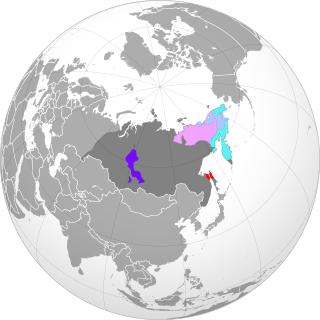
The Paleo-Siberian languages are several language isolates and small language families spoken in parts of Siberia. They are not known to have any genetic relationship to each other; their only common link is that they are held to have antedated the more dominant languages, particularly Tungusic and latterly Turkic languages, that have largely displaced them. Even more recently, Turkic and especially Tungusic have been displaced in their turn by Russian.

The Nivkh, or Gilyak, are an Indigenous ethnic group inhabiting the northern half of Sakhalin Island and the lower Amur River and coast on the adjacent Russian mainland. Historically, they may have inhabited parts of Manchuria.
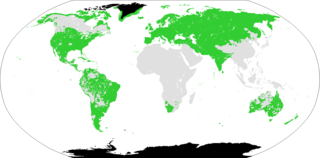
Eurasiatic is a hypothetical and controversial language macrofamily proposal that would include many language families historically spoken in northern, western, and southern Eurasia.
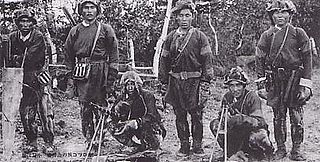
Oroks, sometimes called Uilta, are a people in the Sakhalin Oblast in Russia. The Orok language belongs to the Southern group of the Tungusic language family. According to the 2002 Russian census, there were 346 Oroks living in Northern Sakhalin by the Okhotsk Sea and Southern Sakhalin in the district by the city of Poronaysk. According to the 2010 census there were 295 Oroks in Russia.

Of all the languages of Russia, Russian, the most widely spoken language, is the only official language at the national level. There are 25 other official languages, which are used in different regions of Russia. These languages include; Ossetic, Ukrainian, Buryat, Kalmyk, Chechen, Ingush, Abaza, Adyghe, Cherkess, Kabardian, Altai, Bashkir, Chuvash, Crimean Tatar, Karachay-Balkar, Khakas, Nogai, Tatar, Tuvan, Yakut, Erzya, Komi, Hill Mari, Meadow Mari, Moksha, and Udmurt. There are over 100 minority languages spoken in Russia today.

Borean is a hypothetical linguistic macrofamily that encompasses almost all language families worldwide except those native to the Americas, Africa, Oceania, and the Andaman Islands. Its supporters propose that the various languages spoken in Eurasia and adjacent regions have a genealogical relationship, and ultimately descend from languages spoken during the Upper Paleolithic in the millennia following the Last Glacial Maximum. The name Borean is based on the Greek βορέας, and means "northern". This reflects the fact that the group is held to include most language families that are native to the northern hemisphere. Two distinct models of Borean exist: that of Harold C. Fleming and that of Sergei Starostin.
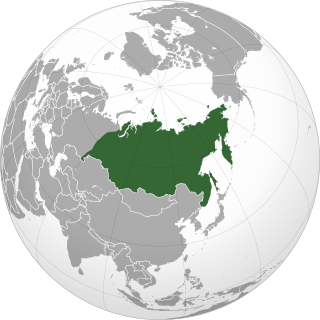
Siberia is a vast region spanning the northern part of the Asian continent and forming the Asiatic portion of Russia. As a result of the Russian conquest of Siberia and of the subsequent population movements during the Soviet era (1917–1991), the modern-day demographics of Siberia is dominated by ethnic Russians (Siberiaks) and other Slavs. However, there remains a slowly increasing number of Indigenous groups, accounting for about 5% of the total Siberian population, some of which are closely genetically related to Indigenous peoples of the Americas.
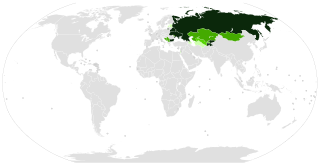
Numerous Cyrillic alphabets are based on the Cyrillic script. The early Cyrillic alphabet was developed in the 9th century AD and replaced the earlier Glagolitic script developed by the theologians Cyril and Methodius. It is the basis of alphabets used in various languages, past and present, Slavic origin, and non-Slavic languages influenced by Russian. As of 2011, around 252 million people in Eurasia use it as the official alphabet for their national languages. About half of them are in Russia. Cyrillic is one of the most-used writing systems in the world. The creator is Saint Clement of Ohrid from the Preslav literary school in the First Bulgarian Empire.

Latinisation or latinization was a campaign in the Soviet Union to adopt the Latin script during the 1920s and 1930s. Latinisation aimed to replace Cyrillic and traditional writing systems for all languages of the Soviet Union with Latin or Latin-based systems, or introduce them for languages that did not have a writing system. Latinisation began to slow in the Soviet Union during the 1930s and a Cyrillisation campaign was launched instead. Latinization had effectively ended by the 1940s. Most of these Latin alphabets are defunct and several contain multiple letters that do not have Unicode support as of 2023.
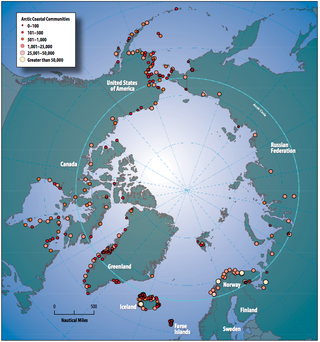
Circumpolar peoples and Arctic peoples are umbrella terms for the various indigenous peoples of the Arctic region.

The Institute of the Peoples of the North is a research and later educationary institute based in Saint Petersburg. Its objective is to examine topics related to the northern minorities in the Soviet Union, and to prepare teachers for the northern boarding schools. One of the central figures involved in the research institute was Vladimir Bogoraz.
The Intercontinental Dictionary Series is a large database of topical vocabulary lists in various world languages. The general editor of the database is Bernard Comrie of the Max Planck Institute for Evolutionary Anthropology, Leipzig. Mary Ritchie Key of the University of California, Irvine is the founding editor. The database has an especially large selection of indigenous South American languages and Northeast Caucasian languages.

The Ainu in Russia are an Indigenous people of Siberia located in Sakhalin Oblast, Khabarovsk Krai and Kamchatka Krai. The Russian Ainu people, also called Kurile, Kamchatka's Kurile or Eine, can be subdivided into six groups.
References
- ↑ "What Languages Are Spoken in Russia?". WorldAtlas. 1 August 2017.
- ↑ Владение украинским языком в России в разрезе этнических групп / Завьялов А. В. Социальная адаптация украинских иммигрантов : монография / А. В. Завьялов. – Иркутск : Изд-во ИГУ, 2017. – 179 с.
- ↑ Hammarström, Harald; Forkel, Robert; Haspelmath, Martin, eds. (2019). "Glottolog". 4.1. Jena: Max Planck Institute for the Science of Human History.